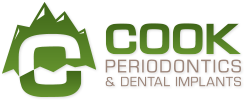Guided Tissue/Bone Regeneration
Guided Tissue Regeneration (GTR)
In health “the periodontium” which is composed of the supporting tissues of: bone, gingiva, (gum tissue), cementum (hard tissue that lines your tooth root surfaces), and periodontal ligament (connects the tooth to the surrounding bone), fit closely around the crowns of your teeth. With periodontal (gum) disease, these supporting gum tissues and underlying bone are destroyed, and periodontal pockets develop around your teeth. As periodontal disease progresses, bone and tissue degeneration continues, and pocket depth increases, leaving large bone defects in the jawbone around the teeth.
These pockets are difficult to clean and most often bleed and are ulcerated and lead to increased bacteria growth and can spread the infection to the surrounding area or directly deposit bacteria into the blood stream. In the most severe cases, the involved tooth or teeth may require extraction because of the severity of the bone loss. Traditional periodontal therapy involves the elimination of these pockets by re-contouring the cratered bone. While very effective in reducing periodontal pocketing and preventing additional bone loss, more sophisticated treatments exist and employed by prudent periodontists. Guided tissue regeneration is an option to address these pockets and reverse the damage by regenerating lost bone, cementum, periodontal ligament and gum tissue.
This surgical therapy involves the minimal reflection of the overlying soft tissue and a thorough cleaning of the teeth and bone defects. A membrane is placed over the surrounding bone defects and underneath the soft tissue. Most membranes in Dr. Cooks practice are bio-absorbable and regenerate tissue without the need for a second surgery to remove them. In a few instances non bio-absorbable membranes are used and these require removal usually 6-8 weeks after they are placed.
Guided Bone Regeneration (GBR)
This technique uses a combination of bone grafting and membrane placement to guide and direct bone formation. This procedure uses bone-grafting material to retain space for future bone growth and then a covering membrane to block the fast-growing soft tissue. Two weeks after grafted, bone begins to form, which will “regenerate” itself filling in the bone defect with healthy bone.
This Reduces pockets through 1) removing existing bacteria, calculus, and tartar deposits and 2) regenerating lost and damaged bone and tissue helps to reduce deep pockets and repairs damaged bone and tissue caused by the progression of periodontal disease.
Guided Tissue Regeneration is recommended where bone and/or soft tissue loss due to periodontal disease has occurred and where GTR will be effective and beneficial. On the other hand GBR is employed for bone destruction due to periodontal disease as well as bone atrophy due to tooth loss for future implant placement.
This therapy results in an improvement in the amount of bone is present around the involved teeth, as well as the shape and contour of the area. The positive result generally depends on each patient’s careful home care. With a combination of good oral hygiene following the surgery and professional cleaning, you should be able to keep your beautiful smile and natural teeth for a long time.
Please contact our friendly staff for a consultation with Dr. Cook. You can get your questions answered regarding guided tissue or bone regeneration and will have your concerns eased about having these procedure’s done in our “state of the art” office.



